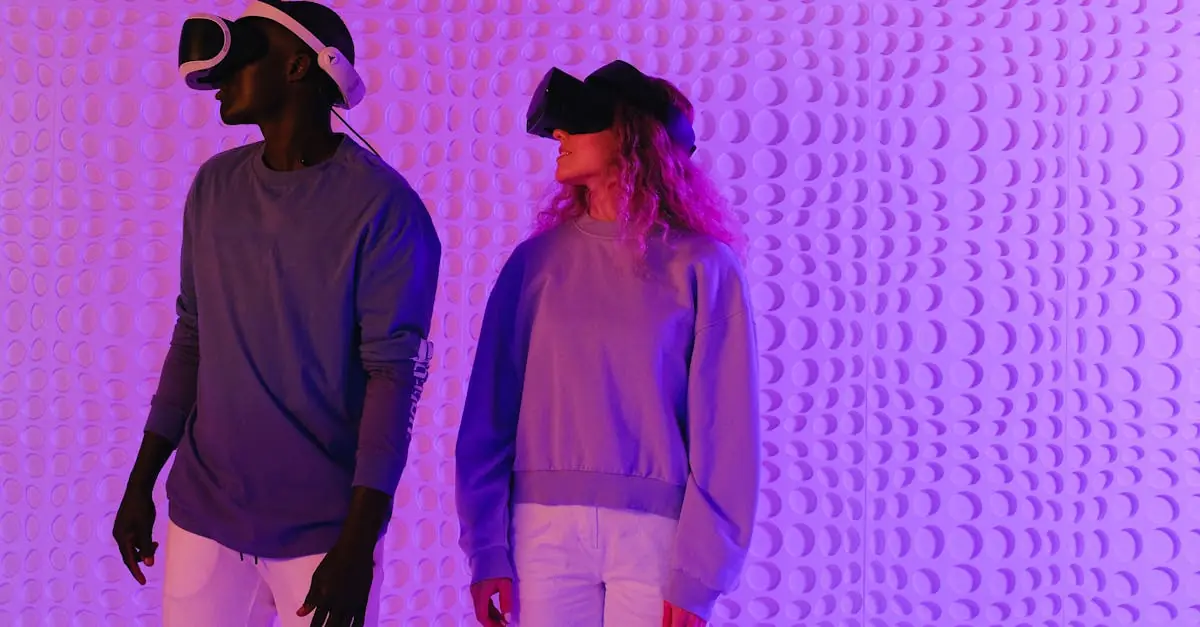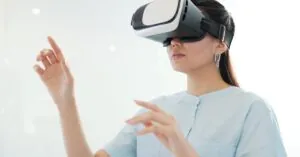Imagine stepping into a world where your wardrobe is as limitless as your imagination. Welcome to the realm of VR fashion, where the only limit to your style is how creative you can get! Gone are the days of struggling to find the perfect outfit in a crowded store. Now, you can try on virtual ensembles from the comfort of your couch, all while sipping your favorite beverage and avoiding the dreaded fitting room mirrors.
Table of Contents
ToggleOverview of VR Fashion
VR fashion redefines the shopping landscape by merging technology with personal style. Consumers now enjoy immersive experiences that allow them to browse extensive collections without the constraints of physical stores. Shopping in virtual reality transcends traditional limitations, making it possible to access global fashion markets at any time.
Accessibility plays a key role in VR fashion. Users can try on multiple outfits effortlessly, experimenting with various styles and colors. Platforms designed for VR fashion provide realistic simulations, allowing individuals to see how garments fit and move in a 3D environment. Virtual fitting rooms enhance the shopping experience by improving confidence in purchasing decisions.
Customization also gains prominence in VR fashion. Customers can tailor clothing to their measurements, preferences, and designs. Virtual designers can create exclusives that cater to individual tastes, fostering unique styles that reflect personal identity. This customization aspect encourages creativity, enabling users to express their personalities through fashion.
Sustainability finds a place in this virtual realm. Reducing returns and waste addresses environmental concerns associated with traditional retail. Virtual outfits can minimize the need for mass production by allowing consumers to visualize and select clothing tailored to their preferences before purchase.
With the rise of social media integration, VR fashion creates opportunities for sharing experiences. Users can showcase virtual outfits, connecting with others and building communities around shared fashion interests. Engaging in this new frontier allows for creative collaboration and inspiration among fashion enthusiasts.
VR fashion stands at the intersection of technology and style, revolutionizing how consumers interact with clothing. Emphasizing convenience, customization, and sustainability, this innovative approach is set to shape the future of retail.
The Evolution of Virtual Fashion
Virtual fashion has evolved rapidly, driven by both technological breakthroughs and changing consumer behaviors. Understanding its progression reveals how far the industry has come.
Historical Context
Early exploration of virtual fashion occurred in the 1990s, coinciding with the rise of digital design. Designers began creating clothing for avatars in online environments. This initial phase laid the groundwork for blending fashion with digital experiences. By the 2000s, online shopping gained popularity, leading to more sophisticated design applications. Virtual fashion gained momentum as platforms showcased digital looks in 3D. Gradually, designers started experimenting with augmented reality, allowing customers to visualize outfits in real-time. The integration of fashion shows into virtual environments further illustrated the potential of digital styling, captivating audiences and shifting perception of clothing.
Technological Advancements
Cutting-edge technologies fuel the evolution of virtual fashion. Innovations in 3D modeling software empower designers to craft intricate garments with precise details. Photorealistic rendering enhances the visual experience, making digital clothes indistinguishable from real-life outfits. Companies leverage virtual reality and augmented reality to provide immersive shopping experiences. These tools allow consumers to try on clothes in digital fitting rooms with ease. Additionally, artificial intelligence improves personalized shopping suggestions, transforming how people discover new styles. As technology advances, the connection between fashion and technology continues to strengthen, expanding the possibilities for creativity and consumer engagement.
Impact of VR Fashion on the Industry
VR fashion significantly influences the fashion industry by reshaping how consumers interact with brands and products.
Changing Consumer Behavior
Consumers increasingly prefer immersive experiences that VR fashion provides. Virtual try-ons replace traditional shopping methods, offering an engaging way to explore new styles. Shoppers enjoy the flexibility of accessing vast collections from home, leading to informed purchasing decisions. The convenience of 3D simulations reduces the likelihood of returns, promoting smarter buying habits. Buyers also embrace social features, sharing outfits and gaining inspiration from their peers online. This shift in behavior signals a move towards a more interactive and personalized shopping experience.
Influencing Designers and Brands
Designers find inspiration in the limitless possibilities of VR. Virtual environments allow for experimentation without the constraints of physical materials, enabling creative expression. Brands prioritize digital collections for their sustainability benefits, minimizing waste associated with traditional fashion lines. Collaborations between tech companies and fashion houses emerge, elevating design innovation. The ability to showcase collections through virtual fashion shows expands reach and accessibility. Brands increasingly adopt VR tools for marketing strategies, enhancing customer engagement through personalized experiences.
Major Players in the VR Fashion Space
Various companies are paving the way in the vibrant realm of VR fashion. Their innovative contributions reshape how consumers interact with fashion.
Startups and Innovators
Numerous startups drive the VR fashion movement. Companies like The Fabricant and DressX specialize in creating digital-only garments, allowing customers to purchase and wear virtual items. Innovative platforms, such as ZOZO, utilize 3D body scanning technology for precise fit, enhancing the shopping experience. Additionally, companies focus on user-generated designs, encouraging creativity and personal expression. Startups often act as trendsetters, exploring new avenues within digital fashion. Their agility and fresh perspectives stimulate significant industry growth.
Established Fashion Houses
Established fashion houses also embrace VR technology. Brands like Balenciaga and Gucci have begun integrating virtual collections into their marketing strategies. These institutions leverage virtual fashion shows to reach larger audiences and offer exclusive digital pieces. Moreover, the incorporation of VR into their websites provides immersive shopping experiences for customers. Notably, these companies acknowledge sustainability, reducing waste with low-impact virtual designs. Strong partnerships with tech firms enable established players to expand their reach in the digital realm. Recognition of the potential in VR ensures that established fashion houses remain competitive in a rapidly evolving market.
Trends Shaping the Future of VR Fashion
VR fashion is rapidly evolving, driven by innovation and consumer demand. These trends significantly influence the retail landscape, enhancing user experience.
Sustainable Practices
Sustainability stands as a core principle in VR fashion. Reducing waste generates attention as brands favor digital garments over traditional production. Organizations leverage VR tools to design clothing without physical materials, minimizing environmental footprints. Lower return rates further contribute to sustainability efforts by decreasing resource consumption. Virtual fashion shows enable brands to showcase collections efficiently while reducing travel and logistics impacts. By embracing sustainable practices, the VR fashion industry leads advancements towards eco-friendly consumption.
Customization and Personalization
Customization enhances user engagement in VR fashion. Tailoring garments to individual measurements allows consumers to create unique styles that express their identities. Many platforms now offer extensive customization options, including fabric choices and design elements. Virtual fitting rooms provide accurate simulations, boosting confidence in purchasing decisions. Personalization also extends to shopping experiences through AI-driven recommendations. Innovative designers utilize customer data to create collections that resonate with specific audiences. As customization becomes mainstream, it transforms the relationship between consumers and brands, fostering deeper connections.
VR fashion is more than just a trend; it’s a transformative force in the retail landscape. By merging technology with personal style, it offers consumers unprecedented convenience and creativity. The ability to explore vast collections and customize outfits enhances the shopping experience while promoting sustainability.
As the industry evolves, collaborations between tech innovators and established brands will likely shape the future of fashion. Engaging in immersive experiences not only redefines how consumers interact with clothing but also fosters a sense of community.
With VR fashion paving the way for a more personalized and eco-friendly approach, it’s clear that this digital revolution is here to stay. The potential for growth and innovation in this space is limitless, promising exciting developments for both consumers and brands alike.



